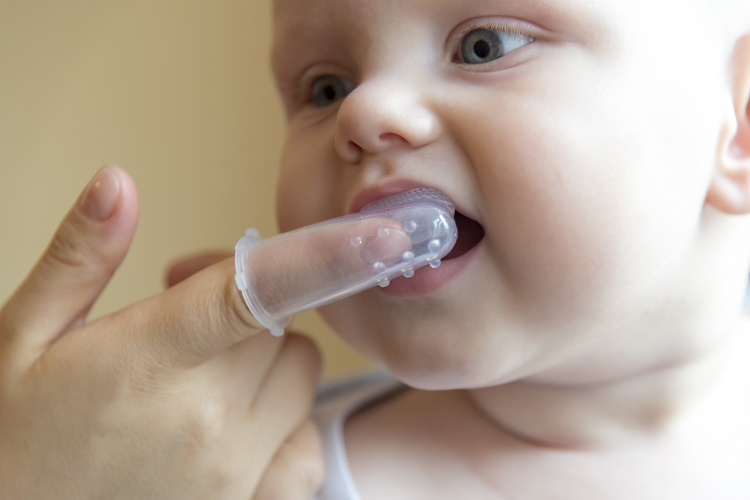
Caring for Baby’s Teeth
Caring for baby’s teeth is very important. Even before your child’s visit to a pediatric dentist, it is parents who should care for baby’s teeth from birth.
Cleaning and Brushing
Begin by cleaning your baby’s mouth by wiping it with a clean, moist gauze or washcloth. Once your child has a tooth, begin brushing that tooth. Until your child is able to spit the toothpaste out after brushing, you will want to use fluoridated toothpaste that is no larger than the size of a grain of rice. Once your child is able to spit out the toothpaste after brushing, usually around the age of three, you can begin using an amount of toothpaste the size of a pea.
Some children become very independent, which is wonderful! Just remind them while they can (and should) have a turn to brush on their own; we as parents also need a turn to ensure the teeth are adequately clean when caring for baby’s teeth. If the primary teeth are touching, flossing is also important for cleaning in between the teeth.
Teething
A major concern for many new parents is “teething”. Typically this begins somewhere between six and ten months of age and continues until about three years of age. When a new tooth is coming in, some children can find this quite bothersome. Typical symptoms can include fussiness, irritability, loss of appetite, increased drooling, trouble sleeping. However, a fever, diarrhea or rash are not typical and should be evaluated by your pediatrician.
As your child’s gums may be sore, gently rubbing their gums with a clean finger, cool moist gauze or washcloth can be soothing. A clean teether made of solid rubber may also help. Avoid any teethers that are liquid-filled teething rings or have any plastic objects that could break and be a choking hazard. Also be mindful of what products were used to make the teether, as it is something going in your child’s mouth. In September 2017, the CDC published a case report of an infant who suffered from lead poisoning after chewing on a homeopathic magnetic hematite health bracelet, which was intended to help with teething.
It is also important to note that topical over-the-counter anesthetics containing Benzocaine have been associated with a rare but serious, sometimes fatal, condition called methemoglobinemia. Methemoglobinemia is a condition where an abnormal amount of methemoglobin is produced. This leads to a tremendous reduction in the amount of oxygen that is effective released to the body. Therefore, the FDA states that Benzocaine products should not be used in children younger than 2 years old and with great caution in people over 2 years of age.
Baby Bottle Tooth Decay
Another serious concern when caring for baby’s teeth is baby bottle tooth decay. Typically it is seen on the upper front teeth, but all the teeth in the mouth can be affected. Cavities are a chronic bacterial infection that is typically passed from the caregiver to the child in the sharing of saliva (e.g. sharing utensils or “cleaning” a pacifier by sucking on it and giving it to the child). Once the bacteria are present, its main food source is sugar. Therefore, infants should only have breast milk, formula or milk in their bottles and should avoid drinks like pop or juice. Infants should also finish their bottle prior to naptime or bedtime. If a child is put to sleep with a bottle in their mouth, the milk, which does contain sugar, will pool in their mouth causing baby bottle tooth decay.
Thumbsucking
Another topic that frequently comes up is thumbsucking and the use of a pacifier. Sucking either the thumb or pacifier can be a natural reflex for children. They can find it soothing and it can help them fall asleep. The intensity, frequency and duration of the habit is what will impact the potential for problems with the growth and development of the jaw and teeth. If your child begins a thumbsucking habit, attempt to replace it with a pacifier, as you are always able to take away a pacifier. Most children will stop sucking their thumb between two and four years old. If you have any questions about this, it is a perfect topic at your child’s one year visit to the dentist.
In conclusion, five key ways to prevent tooth decay:
- First dental visit by 1 year old
- Brush twice daily with fluoridated toothpaste for two minutes each time
- Eat healthfully and drink fluoridated water
- Don’t share utensils, drinks, or “clean” your child’s pacifier by putting it in your mouth; the bacteria that cause cavities can be passed from caregiver to child in saliva
- Ask your dentist about sealants when appropriate
Article by Dr. Kelly Lewis, DDS, Board Certified Pediatric Dentist and owner of Terrific Teeth Pediatric Dentistry in Robinson. Read more of her articles here:

Leave your comment